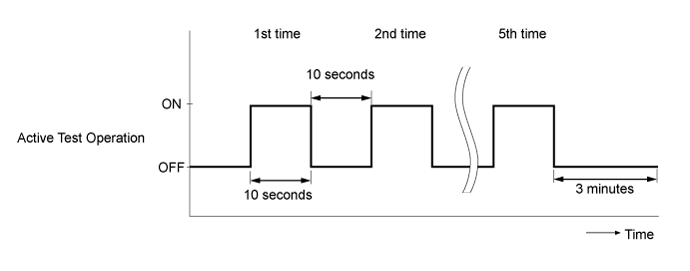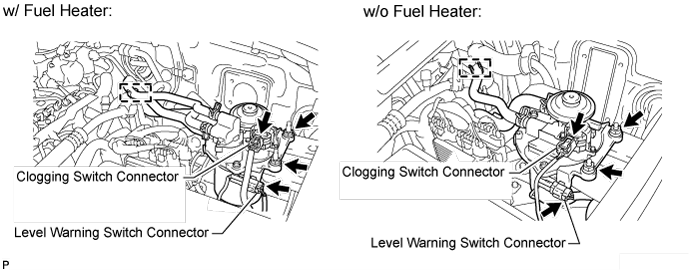Land Cruiser URJ200 URJ202 GRJ200 VDJ200 - 1VD-FTV FUEL
FUEL SYSTEM (w/o DPF) - ON-VEHICLE INSPECTION
| 1. INSPECT FUEL PRESSURE |
Read Data List.
Warm up the engine.
Turn the ignition switch off.
Connect the intelligent tester to the DLC3.
Turn the ignition switch to ON.
Start the engine.
Turn the intelligent tester ON.
Enter the following menus: Powertrain / Engine and ECT / Data List.
Read the Data List.
| Tester Display | Measurement Item/Range (Display) | Normal Condition |
| Fuel Press | Fuel pressure / Min.: 0 kPa, Max.: 250000 kPa | 27000 to 37000 kPa: Idling |
| Target Common Rail Pressure | Target common rail pressure / Min.: 0 kPa, Max.: 250000 kPa | 25000 to 180000 kPa |
| 2. INSPECT FOR FUEL LEAK |
Perform Active Test.
Connect the intelligent tester to the DLC3.
Turn the ignition switch to ON.
Start the engine.
Turn the intelligent tester ON.
Enter the following menus: Powertrain / Engine and ECT / Active Test.
Perform the Active Test.
| Tester Display | Test Detail | Control Range | Diagnostic Note |
| Test the Fuel Leak | Pressurizes fuel inside common rail and checks for fuel leaks | Stop/Start | The fuel inside the common rail is pressurized to the specified value and the engine speed increases to 2000 rpm when Start is selected. The above conditions are preserved while Start is selected. |
| 3. BLEED AIR FROM FUEL SYSTEM |

Using the hand pump mounted on the fuel filter cap, bleed air from the fuel system. Continue pumping until the pump resistance increases.
- NOTICE:
Check if the engine starts.
- NOTICE:
When the engine can be started, proceed to the next step.
If the engine cannot be started, bleed air again using the hand pump until the hand pump resistance increases (refer to the procedures above). Then start the engine.
Turn the engine switch off.
Connect the intelligent tester to the DLC3.
Turn the ignition switch ON (IG) and turn the intelligent tester on.
Clear the DTCs ().
Start the engine.*1

Enter the following menus: Powertrain / Engine and ECT / Active Test / Test the Fuel Leak.*2
Perform the following test 5 times with on/off intervals of 10 seconds: Active Test / Test the Fuel Leak.*3
Allow the engine to idle for 3 minutes or more after performing the Active Test for the 5th time.

- HINT:
- When the Active Test "Test the Fuel Leak" is used to change the pump control mode, the actual fuel pressure inside the common rail drops below the target fuel pressure when the Active Test is off, but this is normal and does not indicate a pump malfunction.
Enter the following menus: Powertrain / Engine and ECT / DTC.
Read Current DTCs.
Clear the DTCs ().
- HINT:
- It is necessary to clear the DTCs as DTC P1604 or P1605 may be stored when air is bled from the fuel system after replacing or repairing fuel system parts.
Repeat steps *1 to *3.
Enter the following menus: Powertrain / Engine and ECT / DTC.
Read Current DTCs.
- OK:
- No DTCs are output.
| 4. CHECK FUEL FILTER WARNING LIGHT AND DRAIN WATER |
w/o Multi-information Display:

Check if the fuel filter warning light is illuminated.
- NOTICE:
- When the fuel filter warning light illuminates, the fuel filter is clogged. Replace the filter ().

Check if the fuel filter warning light is blinking.
- NOTICE:
- When the fuel filter warning light is blinking and the buzzer sounds, immediately drain the water in the fuel filter.
w/ Multi-information Display:
Check the multi-information display.
- NOTICE:
- When the fuel system warning is displayed on the multi-information display and the buzzer sounds, replace the fuel filter () or drain the water in the fuel filter.
Drain water.
Detach the fuel hose clamp.

Disconnect the clogging switch connector and level warning switch connector.

Remove the 2 nuts and lift up the fuel filter assembly.
Connect a hose to the drain cock. Place the other end of the hose into a container under the drain cock.
Loosen the drain cock to drain water.
Tighten the drain cock by hand.
- NOTICE:
- Do not use any tools in this procedure.
Install the fuel filter assembly with the 2 nuts.
- Torque:
- 20 N*m{ 199 kgf*cm, 14 ft.*lbf}

Connect the clogging switch connector and level warning switch connector.
Attach the fuel hose clamp.